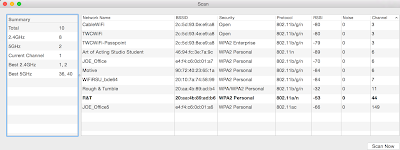How to Validate Hospitality Wi-Fi in Five Minutes Using Any Old Mac

Do you own, manage, or provide technology services for a classy hotel? Yes?? Then this blog's for you. No, we are not going to reveal the secrets of luring wealthy clientele via watered-down booze and disreputable ladies. Those things are obvious, and if they're not obvious you should ask a French person. (One of my best friends is French, so I can say that... I think.) We are going to reveal how to quickly validate your other most important service -- Wi-Fi -- using free, built-in Mac software. The nice thing about providing Wi-Fi service at an upscale hotel (or other hospitality environment; convention centers, cruise ships, et al. count too) is that wealthy people hate to complain. (Publicly, that is. Privately that's all they do.) The not-so-nice thing is that wealthy people are big fans of ghosting. They will abandon your upscale hotel with the quickness if service of any kind dips ...




